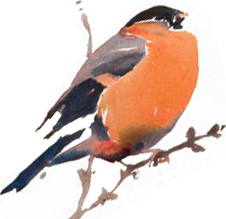With spring on the doorstep thoughts are turning to the breeding season and the chance to chart the progress of the breeding birds of Scotland. Many of you will be out monitoring your favourite species or sites, and hopefully submitting all your records to the local SOC bird recorder.
The UK Rare Breeding Birds Panel collates and reports on the status of the rarer breeding birds across the UK. A rare breeder is classified as a species with fewer than 2,000 breeding pairs in the UK. You may have seen the Panel’s annual reports in British Birds; the most recent covered 2014 was published in September 2016. The RBBP Secretary is currently (March 2017) busy processing all the data received for 2015, ready for the next report, and come the summer calls will be made to SOC recorders for their 2016 data, so if you have not sent your records for last breeding season in yet, please do it soon so that they are available to the recorders for inclusion in their annual submission.
But back to this year. Both SOC and the RBBP encourage you to submit all your records on BirdTrack and this recommendation includes records of rare breeding birds. (Note that if you feel a species or site is sensitive and you want the recorder to know that, you can flag the record as sensitive). We are not only looking for records of confirmed breeding (such as nests with young, recently fledged young or adults carrying food for young) but also records of probable breeding (pairs in breeding habitat, nest building, territorial or display behaviour) and possible breeding (singing birds or simply individuals in breeding habitat during the breeding season). Migrating birds, clearly on passage, would not be counted as breeding but with rare species remember anything can happen and a migrant may choose to stay and hold a territory (Marsh Warblers and Red-backed Shrikes have done this in recent years). So even though a pair of Garganey in April or early May are likely to be birds on passage, a single male later on at a site where a pair was present earlier might indicate possible breeding, and other records later in May or June might be sufficient to raise the level to probable breeding. The same criteria go for ‘resident’ species such as Wigeon, Shoveler and Pochard – lone males seen in late May or early June when a pair was present earlier, could well represent a breeding pair. Go back and look for a brood with the female later! To help the recorder interpret these records, you can see how important it is to give a separate count of both sexes, and of small young – BirdTrack has facilities to enter this, or if you are using the BirdTrack app on a smartphone, you can put the details in a comment.
It is also incredibly useful to recorders to understand the level of breeding evidence and to determine how many pairs are breeding, or potentially breeding, at a site, if the breeding evidence code is entered on BirdTrack – these are the same codes as used in Atlas projects so will be familiar to most of you, and in any case BirdTrack offers you a choice from drop-down menu, even on the app.
Not all of the species on the list are rare from a Scottish perspective and although many of them receive extra protection during the breeding season through Schedule 1 of the Wildlife & Countryside Act 1981, their presence in breeding habitat can often be monitored from a safe distance without disturbing the birds. As always, follow the Birdwatchers’ Code of Conduct and put the welfare of the birds and their nests first. There is absolutely no need to approach the birds closely to take a photograph, and anyone deliberately going close to a nest is in contravention of the law and could face prosecution.
A final comment. There are some species which, though on the RBBP list, are poorly recorded, and Scotland holds important populations of these birds. For birders in SW Scotland, any record of Willow Tit from March through to July is relevant (and can be at least assigned to birds in breeding habitat) and early spring in any wooded part of Scotland is the best time to locate displaying Goshawks. Our knowledge of the population of Goshawks is limited because most records received by the RBBP relate to nesting pairs monitored by licensed raptor workers, but any birdwatcher can help by reporting any bird seen in nesting habitat. And then there is a suite of species which are under-recorded in the breeding season. Wigeon has been mentioned but other poorly recorded water birds are Goldeneye, Red- and Black-throated Divers, waders such as Greenshank and Whimbrel, and Snow Bunting. All records of both Long- and Short-eared Owls in breeding habitat from April to July are also invaluable in assessing the total breeding population.
Diligent observers may be the first to find breeding Little Egrets or Cetti’s Warbler in Scotland!
We wish you all the best in your endeavours to track breeding birds in Scotland and the RBBP looks forward to including the results of your time in the field in our annual summaries. Mark Holling, the RBBP Secretary, would like to thank all birdwatchers and SOC recorders in Scotland for their important contributions – without your efforts the RBBP could not do its important work for the conservation of birds. If you would like to know more about the work of the RBBP, take a look at www.rbbp.org.uk, where you can find a full list of species covered by the Rare Breeding Birds Panel.
Mark Holling, RBBP Secretary
Short-eared Owl by Laurie Campbell




